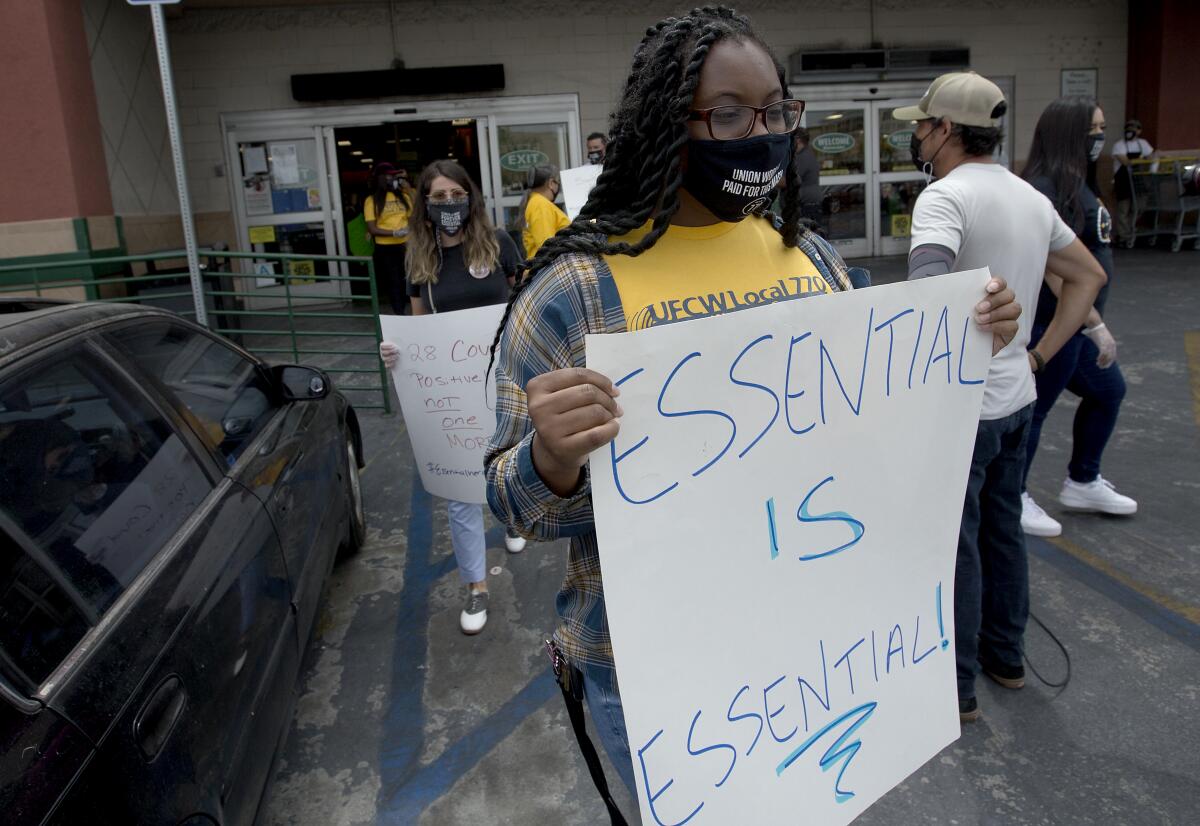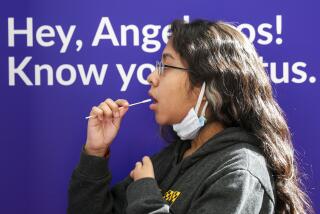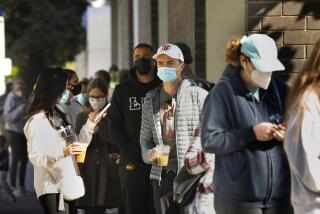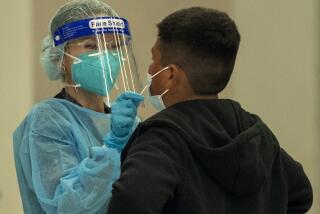Coronavirus data failures add to California’s struggle to deal with pandemic

This started as a week of positive news, finally, in California’s battle with the coronavirus. After nearly two months of skyrocketing cases, hospitalizations and deaths, there were the first signs that the COVID-19 spike was ebbing and new cases were beginning to decline.
But by Friday, state officials were still scrambling to fix a coronavirus-tracking database that had suffered glitches, rendering the numbers inaccurate. It came as the state marked another sober milestone: 10,000 deaths from the virus.
The breakdown in the electronic collection of coronavirus test results has further rattled confidence in how the state is responding to the coronavirus in recent months. It’s a big turnaround from the spring, when California was hailed as a model for the nation.
Dr. Mark Ghaly, California’s health and human services director, said Friday that between 250,000 and 300,000 results have not been uploaded to the database. Some of those are either duplicate records or tests for other diseases the department keeps track of. And to this point, the vast majority of coronavirus results have been negative.
Ghaly says the glitch would probably not change the picture of the state’s progress when it is recorded.
“We believe that the trend is stabilizing and coming down,” he said.
But after a long, deadly summer turned California from exemplar to cautionary tale, officials and residents alike were floored to learn that the data being used to make life-changing decisions — whether to keep schools and businesses closed, among them — were unreliable.
In the state’s hard-hit Central Valley, leaders worry the problem will erode the already limited confidence in the government’s response to the virus.
“We’re very concerned about it both from a health and safety perspective but also from a public trust perspective,” said Stanislaus County Supervisor Kristin Olsen. “It is very hard to garner community trust and compliance if they don’t have faith in the numbers being reported.”
Even officials in counties largely in sync with the state’s approach were frustrated.
“These metrics as a whole are what we used to guide our decision making,” Los Angeles County health officer Dr. Muntu Davis said during a news briefing Thursday. “At the moment I don’t have clear expectations or understanding of what the state is finding in terms of their investigation [of the missing data].”
In Orange County, where officials have at times cast doubt on the accuracy of hospitalization data and case counts, Supervisor Michelle Steel said the correct total number of infections was critical to the county’s plans to reopen.
“The public health officials and policymakers across the state rely on this data to understand COVID-19’s spread and make decisions on opening and closing schools, business and gatherings,” she said. “It is essential to know the extent of the problems with the CalREDIE system and understand how it is affecting the data we report.”
Without an accurate picture of confirmed cases, many local officials who rely on the California Reportable Disease Information Exchange (CalREDIE) have scrambled to conduct their own tallies to understand the spread of the virus in their communities. Several counties throughout the state are applying for waivers to reopen schools. That allowance, like counties’ permission to reopen certain businesses, relies heavily on data tied to case counts and hospitalizations.
Since officials discovered the backlog, the state stopped adding and removing counties from its list of areas experiencing higher rates of transmission, which subjects them to more restrictions than other parts of California. Thirty-eight counties, representing 97% of the state population, are currently on the list.
San Mateo County Health Officer Dr. Scott Morrow expressed dismay Thursday over the state’s decision to freeze its watchlist, and doubted that the numbers affect the county.
“I wish to apologize to all the businesses that were closed this week. I am not supportive of these actions and, for San Mateo County, I believe they are misdirected and will cause more harm than good,” he said in a statement Thursday. “Our numbers indicate we are in a relatively stable state in regards to the spread of the virus.”
In the early days of the pandemic, California was a leader in the response. It was the first state to impose a stay-at-home order, and that was credited with keeping cases and deaths lower than in hot spots such as New York and New Jersey. But California rapidly reopened its economy in May, and experts say that led to a jump in cases.
By July, Gov. Gavin Newsom and other leaders had rolled back some of the reopening, and there are signs those changes are helping slow the outbreaks.
California — the nation’s most populous state — now leads the nation with more than 500,000 confirmed cases. But even at 10,000 deaths, it remains far behind New York, which has recorded more than 30,000 fatalities.
It’s unclear if the lost test results are scattered throughout the state or contained to a small number of counties. Statewide trends do not always mirror individual counties’ experiences. Los Angeles County is approaching 5,000 fatalities and has topped 200,000 cases. Trinity County has had two confirmed cases.
Earlier this week, L.A. County officials said that the lost numbers could have a large effect on its caseload.
“We are really worried that we’re losing some cases and that may in fact result in some small increases in transmission in the weeks ahead,” L.A. County Public Health Director Barbara Ferrer said Wednesday.
The county went as far as to contact 81 labs to retrieve the accurate count of lost data. In an attempt to retrieve a full count, independent from the state, officials also asked residents to contact the public health department if they tested positive.
Ghaly said Friday that the state is developing a new coronavirus tracking system because of the recent deficiencies of CalREDIE
“Simply put, the CalREDIE system was not built for this volume of data,” he said. “In order to create a lasting solution, we are accelerating the development of a new laboratory reporting system for COVID-19.”
Ghaly said the state would work through the backlog of records over the next 24 to 48 hours. He said state missteps compounded a problem that began with a server outage, and he promised a full investigation.
He added that the data snafu had no effect on hospitalization or death data and the state did not change its response policies based on the incomplete information. The state reported 6,069 patients hospitalized with COVID-19, including 1,828 in intensive care, as of Wednesday.
In describing the problem, Ghaly said a July 25 server outage created a delay in records coming into the state’s lab reporting system.
The state implemented what he described as “technical changes that allowed the records to flow into the system more quickly.”
The changes were supposed to be temporary, Ghaly said, but the state did not disable them, “causing further delays in our reporting of lab data and creating an extensive backlog.”
“Simultaneously, we discovered that we were not receiving data from one of our largest commercial labs for a period of five days,” Ghaly said. “This was due to a certificate that the state neglected to renew timely. This resulted in data not being able to transmit to the state.”
Ghaly identified the lab as Quest Diagnostics and said the company had been unable to send test results to the state from July 31 through Aug. 4.
It is unclear if Los Angeles County’s caseload has been affected.
CalREDIE was first connected to public health departments across the state in 2012, receiving a government technology award that summer.
But though it had been used for other important statewide efforts in the past — notably in helping gather information over concerns about the Zika
virus beginning in 2015 — such uses were much more limited than its central role during the COVID-19 pandemic.
Some local health officials complained in late March that not all labs were connected to the statewide system. And in late June, sporadic reports appeared from some counties of problems with the system’s data.
When asked why it took so long for local concerns about the system to come to his attention, Ghaly said he’s working to understand the communication issues at California Health and Human Services and the California Department of Public Health.
“We are aware that individuals there were knowledgeable of some of these challenges, and we are doing a complete look into how that communication both could have been better and where it went wrong,” Ghaly said.
More to Read
Start your day right
Sign up for Essential California for news, features and recommendations from the L.A. Times and beyond in your inbox six days a week.
You may occasionally receive promotional content from the Los Angeles Times.









